How to grow a small business, plus 4 practical strategies

When trying to grow your small business, you can benefit significantly from practical strategies that help you navigate a larger market, manage more tasks, and increase profitability—all while giving you the time to focus on delivering that quality product or service that you and your customers are passionate about.
To help you grow and manage that growth, this post covers four practical strategies that you can use, specifically:
- How to grow your small business online, using tools like your Yelp Business Page, website, and social media to market your business and connect with an audience looking for your services
- How to grow your business with in-person networking to get more local customers
- How to refine your sales funnel to help maintain a steady flow of new customers and improve customer retention
- How to boost your productivity with automation or outsourcing so you have more time for the tasks that need your personal touch
What’s more, many of these strategies help you gather key information that can inform your strategic decisions, helping you stay flexible and adapt as your small business grows into a larger one.
1. How to grow your small business online
A strong and strategic online presence can help potential customers find your business, understand what makes it unique, and contact you when they’re ready to book or buy.
In this section, you’ll find tips for building a cohesive online presence that targets your specific audience, including:
- Using all the features of your Yelp Business Page and increasing exposure with Yelp Ads to attract your ideal customer
- Optimizing your website to attract the right audience
- Using social media platforms to build relationships with new and existing customers
- Sending marketing emails to keep your customers informed and encourage repeat business
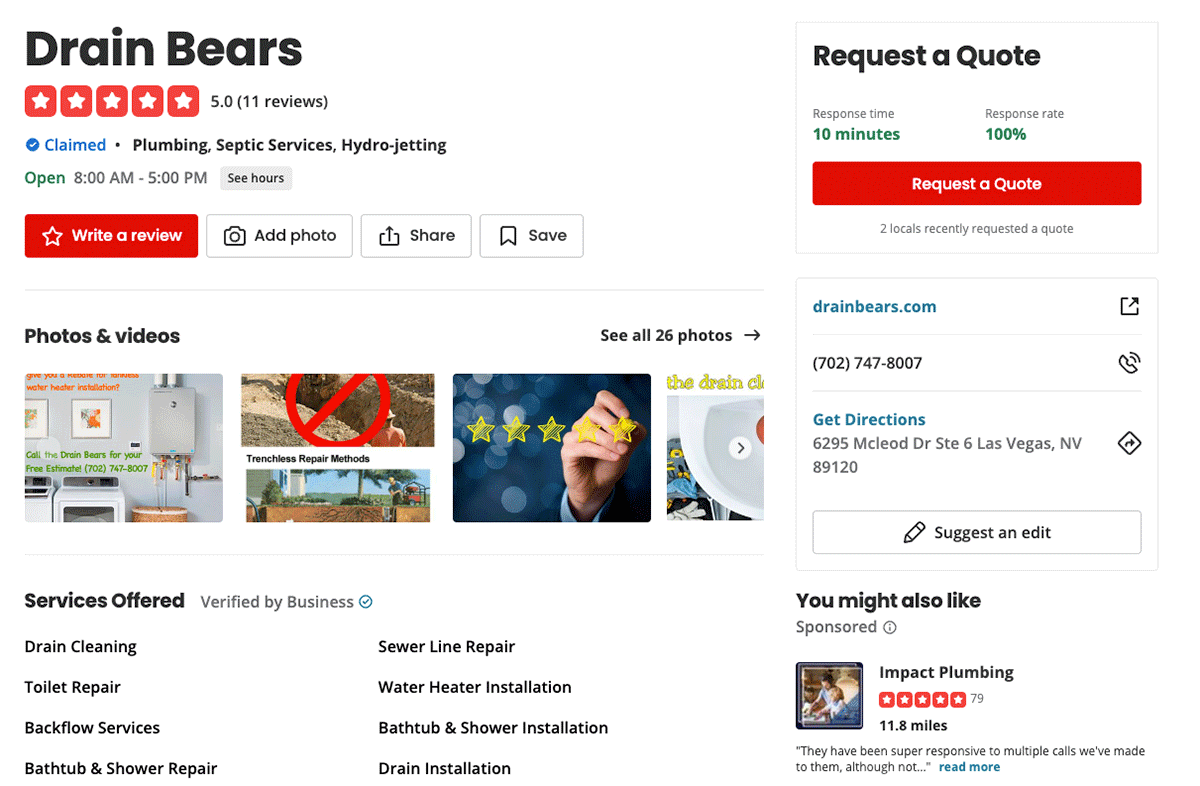
Note: We found this business by searching for plumbers near Las Vegas on Yelp.
Use all the free features of your Yelp Business Page
Your Yelp Business Page can put your business in front of a larger number of high-intent searchers.
- 76+ million people visit Yelp each month, and these people are usually looking to find and compare businesses in their local area
- 82% of users hire or buy from a business they found on Yelp within a week
- 57% of users contact a business they researched on Yelp within a day
People who search for a business on Yelp tend to have an idea of what type of business they’re looking for, without having a specific business in mind. 8 out of every 10 searches for businesses on Yelp don’t include a specific business name.
For example, if someone is searching for HVAC companies on Yelp, then they’re likely looking for HVAC services, whether that’s air conditioning repair or installation. If someone is looking for a real estate agent, then they’re likely looking for someone to help them find their new home. In these instances, they know what they need, but they don’t yet know who they’ll do business with.
To start using Yelp to its full benefit, add or claim your free Yelp Business Page. If you already have a Yelp for Business account, simply log in.
Whether your business is brand new to Yelp or you already have an account and are logging in to make updates, you want to do two things.
- First, make sure the details on your page are complete and correct. This includes contact info, business hours, location, the services you offer, and more.
- Second, try to give as much information as possible about your business and your services. This helps potential customers determine if you’re what they’re looking for.
According to a Yelp survey, the top three things consumers say are important when choosing a business on Yelp are the ratings and reviews, photos and videos, and critical business contact information (phone, website, address).
Get found for free
Show up for any of the millions of customers on Yelp searching for a business like yours.

Here are just some of the free features that you get when you use Yelp.
- Key business information, such as your contact info, location, business hours, and the services you offer.
- Request a quote or request a call button. This makes it easy for potential customers to reach out to your business to share details about a job or service they’d like to request.
- Photos. Upload photos to showcase your services, products, and more, helping you humanize your business and give customers a look at what they can expect.
- Yelp reviews. When past customers leave reviews on your Yelp Page, that’s a great way for new potential customers to learn more about your business and services. Respond to each review to show your potential customers how you interact with your current customers.
Plus, your free Yelp Business Page also has performance tracking and analytics features, allowing you to track page visits, customer engagement, and more. This can help inform your future decisions so you can get the most from your page as your business grows.

Upgrade your Yelp Page for even more features
Small business owners get extra benefits when they upgrade their Yelp Business Page with the Upgrade Package, a set of features that boosts the appeal of your page and your business, such as:
- Business Highlights, which are icons that illustrate your business features and values front-and-center, so people can see what makes you unique.
- Removal of competitor ads from your page, so people are less likely to become distracted and go to another business.
- A customizable Call to Action (CTA) button that sends people straight to your website or booking portal, increasing the chance they’ll follow through and become your customer or client.
- Yelp Connect, which lets businesses share updates and news. This can be a great place to introduce new products, services, or promotions or invite customers to an event your business is involved in.
- Additional visual features, like Slideshow, Portfolio (select categories), and Logo, that give you more control over how your page looks and more opportunities to showcase your brand.
This Yelp Business Page from The Eisenhauer Team, a real estate company in Vancouver, Washington, has Slideshow, Logo, Yelp Connect, Portfolio, Business Highlights, and a CTA.
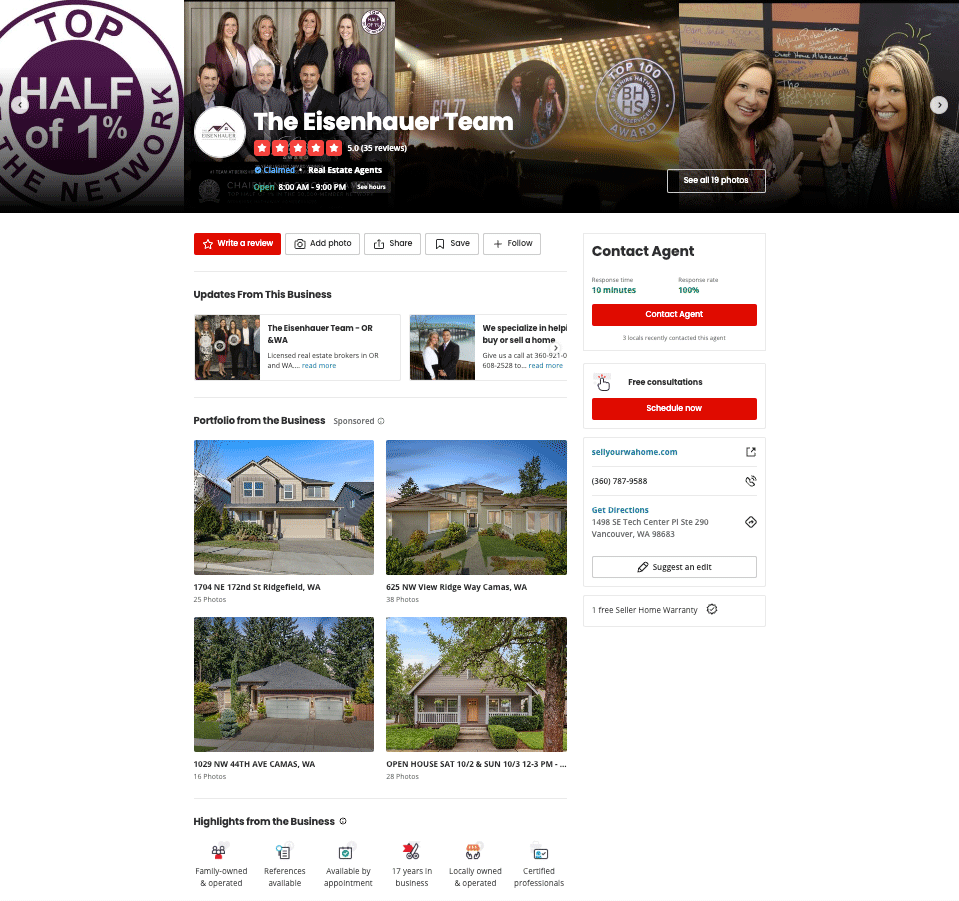
Note: We found this business by searching for real estate agents near Vancouver, Washington on Yelp.
And here’s an example of an upgraded page that shows the Portfolio feature, which lets businesses showcase photos of their services.
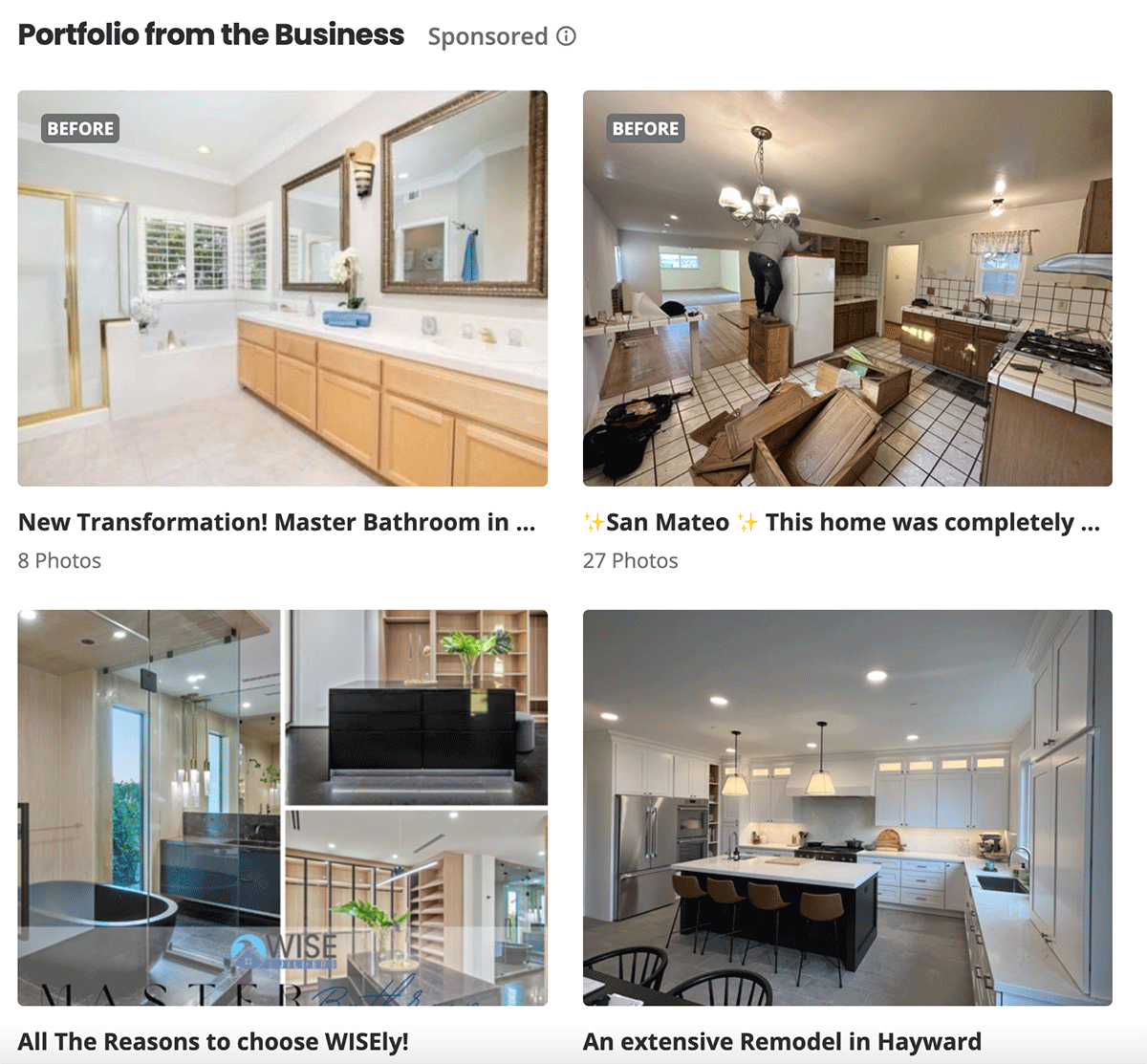
Increase your exposure with Yelp Ads
Once your Yelp Business Page is filled out, you can use Yelp Ads to spread the word about your growing business – in fact, businesses get 4x more leads with Yelp Ads.
Businesses that advertise with Yelp Ads appear in a number of key places on the site and app, including above relevant search results and on competitors’ pages.
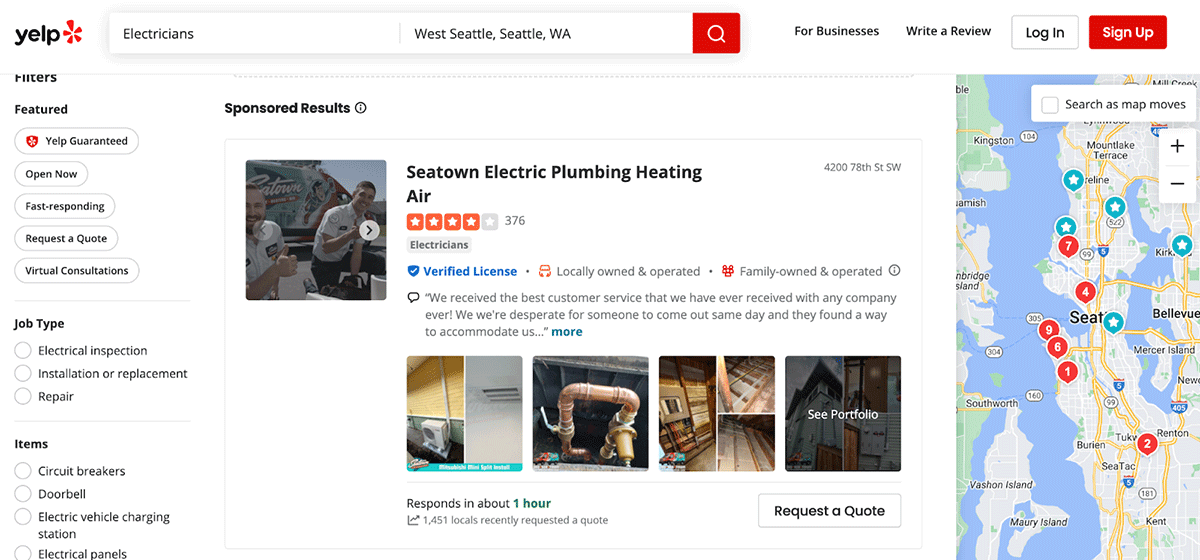
Business owners who advertise on Yelp also have access to another dashboard of tracking and analytics features. Monitoring information like impressions, leads, and your average cost-per-click lets you see exactly how your ad is performing, helping you to optimize your marketing strategy as your business grows.
One of the best features of Yelp Ads for small business owners is control over advertising costs. You set a daily budget, which is only used when someone clicks on your ad, and you can adjust that budget at any time. Plus you can pause your ad whenever you need to.
And to make sure your ad is as effective as possible, you’ll also have access to the Yelp Ads customer support team to help you get the most from your daily budget.
Get more leads
Reach more customers with placements on search and competitors' pages.

Customize your website
Having a professional website is an asset to many different marketing strategies. For example, you can run ads on social media platforms that direct traffic to your website, which has a full list of the services you offer.
Designing a website doesn’t have to be intimidating. If you don’t want to hire a web developer or code a site yourself, you can subscribe to a website template service like Wix or Squarespace. These services also let you add an online store if you sell a product that you want listed on your site.
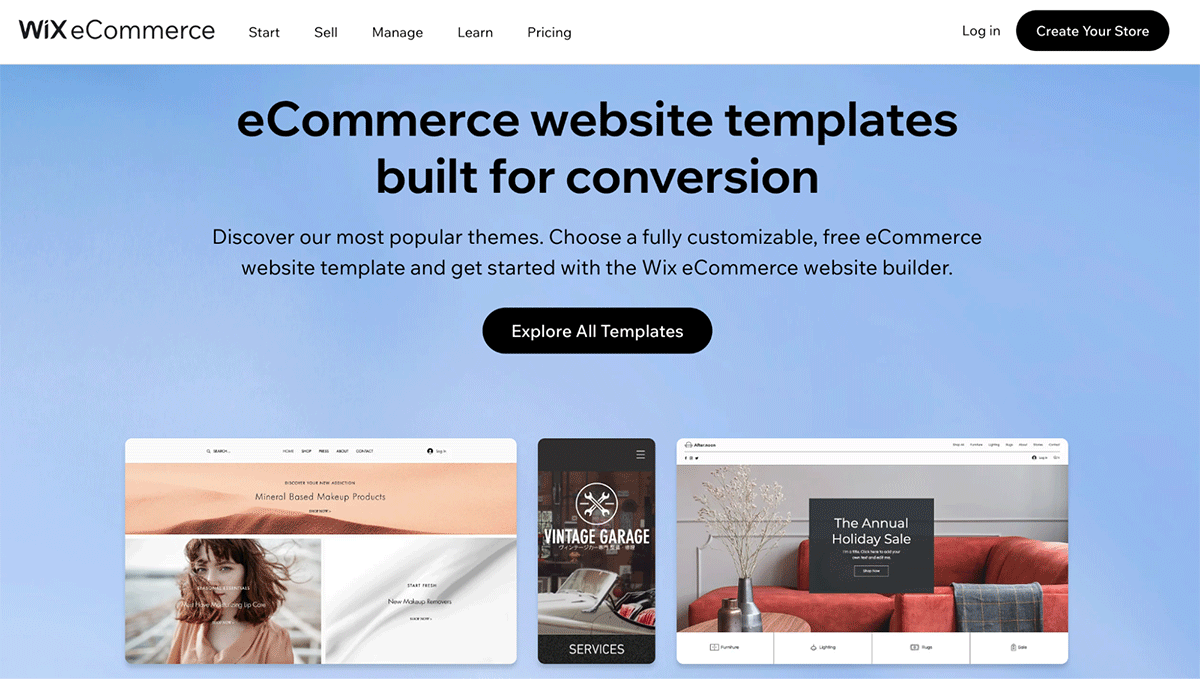
Your website can also be a great way to get information about your potential customers. Analytics plugins can give statistics on the time people spend on a page, the links they click to navigate your site, and the pages they view before leaving. This information can help you optimize your site and plan the rest of your marketing strategy.
For example, if you’re a beautician and people spend a lot of time on the page about your options for facials, you can assume the information is relevant and push this service on your other marketing channels. But if people tend to leave your site after viewing your page about eyebrow shaping, you can find ways to make that content clearer or more useful so future visitors stay on your site (or even book an appointment) after they’ve viewed the page.
Remember to give any changes you make to your site time to take effect. You may not always see an immediate difference in the analytics data after you update a page. But as your business grows, a fresh and user-friendly website is one of the most effective ways for local and national businesses to grow their customer base.
If you’re interested in more tips for your business website, find more information on web design for small businesses.
Use social media to engage your audience
In addition to being a way to give your customers more information about your business, social media can help build relationships and brand awareness. And because people in your audience can share your posts with their followers, sites like Facebook, Instagram, and even LinkedIn can give you access to a wider audience who might never have found your business through a search engine. This is a bonus for small business owners who want to extend their reach.
These tips can help you to get the most out of the time (and even budget) you devote to your social media profiles.
Create value-driven content
When creating social media posts, you want to make value-driven content that is entertaining, informative, and useful to your target audience. This helps increase engagement with your content.
For example, if you’re a personal trainer trying to get new clients, then you can create a series of social media posts that explains the kind of exercise or routines you offer to your clients. If you’re a trainer focusing on hip mobility, then you can create posts that cover a few different stretches and exercises to help with hip movement. That’s not only valuable content, but it’s content that gets your potential customers engaged with your business.
Gather analytics data
Nearly every social media platform can offer you some type of analytics data about who your audience consists of. For example, when you post as a business on Facebook or Instagram, you have access to the Meta Business Suite.
This backend of your page gives you information on how many impressions and engagements your posts are getting. You can use this to plan the social media strategy for your growing business by understanding which content is successful, when your audience is online, and the age and location demographics they represent. You can even A/B test potential posts on Facebook to get an idea of which one your audience will respond to.
If you want to learn more about using social media to effectively grow and engage your audience, check out social media for small businesses.
Keep your audience informed with email marketing
Email marketing is another way to build awareness of the products and services your business offers. This approach can be an especially effective way of connecting with customers if your business is more difficult to sell on social media—for example, it’s niche, it’s a professional service, or it’s not very visual.
When you’re planning your email marketing strategy, it’s important to differentiate between:
- Marketing emails, which help sell your product or inform people of upcoming opportunities to buy.
- Transactional emails, which follow up on or confirm a purchase, subscription, or booking.
- Operational emails, which update people about changes in your business, like holiday opening hours or events.
- Informational emails, which help you engage with your audience by providing them with educational content that’s relevant to your business. For example, a gym might send out emails covering exercising and nutritional tips.
Every email you send to your mailing list is an opportunity to build a positive impression of your business, but every type of email needs a different approach.
Here, it can also be effective to “segment” your email list. For example, you can send your returning customers a different version of the information than prospective customers because you know they’re likely already familiar your product.
And if you’re asking yourself how you can grow your mailing list, consider the following options:
- Landing pages let people enter their contact details to get something they want—like a signup bonus or a downloadable pdf guide or e-book. The resource you offer is sometimes called a lead magnet because it attracts new customers.
- Pop-ups invite people to enter their details once they’ve shown they’re interested by spending a certain amount of time on a page.
- Sign-up forms let new customers add themselves to your mailing list so you can give them news from your business in the future.
- Customer surveys or physical feedback forms at your location invite people to give suggestions for improving your business.
2. Grow your small business with in-person networking
When you work locally, making personal connections with people in your area can give you the boost you need as your business grows. Even if the people you connect with at local events aren’t in the market for your services right now, they might remember your name the next time their friend or colleague needs a recommendation.
Building relationships through in-person networking is also an opportunity for market research. By talking to potential customers and other business owners, you can get a deeper understanding of their pain points and their opinions on what your local area needs.
Network at local events
Many larger towns and cities have a chamber of commerce, board of trade, or another business network. As a business owner, you may be eligible to attend their events.
As well as using this as an opportunity to mingle and find out about what’s going on in your area, you might also be able to give a talk or run a stand at one of these events. For example, if you make a physical product, you might be able to exhibit at a craft show. Or if you’re in the wellness business, you might be able to have a booth at a health fair.
Make connections with adjacent businesses
A partnership with another local business can benefit you both. This strategy is particularly effective if you work in an industry where people tend to book more than one service at a time, like events, relocations, or renovations. In this case, each of you could refer customers to the other.
For some businesses, partnering with local suppliers can also be an added value proposition for their products or services. For example, a cake decorator could work with a local florist or grocer to supply fresh produce for their celebration cakes.
Hold a launch event to celebrate your business expansion
Expanding your business is a huge achievement and an opportunity to celebrate. Hosting an event to launch your new product, online store, or new branch is a good excuse to invite people to come to your location. This can help you grow your business by giving new customers a chance to see, feel, or taste your product in person.
You may be able to attract more people to your launch event by offering an incentive like an opening discount, free samples, or catering. Although there’s some cost to organizing an event like this, people who have been to your location once are more likely to come back again and give you repeat business.
Yelp Connect, your website, and your mailing lists are good places to announce an opening event and encourage people to sign up. You can also use social media to help spread the word. And if your event looks great in photos, you can encourage your guests to post their pictures and tag your location in their social media feeds, giving you an extra boost of publicity to grow your audience following the launch.
Establish a loyalty program to keep customers coming back
While getting new customers is important, it’s easier to grow a business if your old customers keep returning.
A loyalty program for repeat customers or clients can help keep you at the top of people’s minds. You could offer additional benefits like early access to a sale or new product, a gift with purchase, a small discount on every visit, or a loyalty card where if they come to you nine times, the tenth is free.
As well as a loyalty program, you could consider establishing a referral program for people buying online or booking appointments. If one of your existing customers recommends you to their friend, they both get a discount when the friend completes their first transaction. If you can keep those referrals coming back, this version of a loyalty program could help give you a steady stream of new and repeat business.
3. Refine your sales funnel
The strategies above can help you find new customers and increase their awareness of what your brand stands for. One of the best ways to keep your business on this upward trajectory is to hone your sales funnel.
A sales funnel is a plan for moving people from “someone who has heard of your product” to “loyal customer.” It is often divided into five levels:
The lead
A lead is someone who’s part of your target market, but who you haven’t connected with yet. When you communicate with leads, your job is to build awareness of what your business does and how it can help them.
The prospect
Once you connect with your lead, they become a prospect. Prospects have heard of your product or service and they’re likely at least a little bit interested. It’s important to remember prospects are still weighing their options. They’re not guaranteed customers, and they probably won’t appreciate the hard sell. This stage is about helping them discover more about your product.
The qualified prospect
A qualified prospect has told you they’re interested in becoming your customer. This means your job is to find out what has to happen for them to follow through with the transaction.
The committed prospect
When someone takes action and gives you an official yes, they become a committed prospect. You should move quickly to complete the transaction and give the best possible impression of your business.
The transaction
Finally, there’s the transaction stage, where you complete the purchase and thank someone for choosing your business.
Although this last phase is the bottom of the sales funnel, it’s an important chance to build rapport and work on turning these new customers into loyal customers. It’s far easier to retain a customer at the bottom of the funnel than to complete all the smaller interactions that will move a lead to the transaction stage.
Tailor your interactions to each stage of the customer journey
A sales funnel can be more effective if you communicate with people at different stages in different ways. People who work in sales call this “nurturing your leads.” Using the personal touch to show people their time and business are valuable to you is an important part of this process.
For example, If you know a prospect is interested, but can’t visit your store during normal opening hours, you could invite them to an evening event or introduce them to your new online store. On the other hand, an email about new products only available when your store is open from 9–5 might make them label your marketing messages as spam.
If a committed prospect plans to buy something from you but hasn’t completed their purchase yet, they might respond to a reminder message offering to answer any questions they have.
And if someone has bought from you before and you know they’re due to receive your services again soon, you could offer them a discount or mention your loyalty program around the time you’d expect them to notice they’re due.
4. Boost your productivity by becoming more efficient
When you expand your business, you’ll probably find yourself with much more to do. These strategies can help you manage your time and work efficiently, which should give you more time for the jobs that need your unique skills as the owner of the business.
Outsource the tasks someone else could do
If your business has a physical office or venue, consider hiring a cleaner to take care of housekeeping rather than doing it yourself. A clean and organized workspace is more attractive to your customers, and you’ll probably find it easier to work there too.
Instead of wrestling with your tax return alone, you could also work with an accountant. Although it’s a large additional expense, it can save you a lot of time and energy, especially as your business grows and adds additional financial considerations like rent or extra salaries.
Once you’ve brought someone up to speed with your vision, marketing is another common area to outsource. Depending on the size of your business, this could mean working with a freelancer for a few hours a week to write the captions for your social media content or hiring a marketing manager.
Automate time-consuming or repetitive tasks
Running a larger business also comes with a lot of additional admin. For example, instead of writing dozens of invoices to go out with your orders every month, you might be writing hundreds.
As a business owner, you can invest in software to help you to manage almost all of the repetitive or time-consuming administrative tasks that your growing business demands.
Not only do these solutions let you power through your to-do list more quickly, but they can also help you to eliminate mistakes and personalize your communications with your audience. This can help you to provide better customer service than if you tried to do everything yourself.
- Accounting software like Quickbooks lets you generate invoices and keep track of your earnings and expenses in one place. A service like this can also make your end-of-year accounting more manageable.
- Customer relationship management (CRM) software holds your customer data securely and makes it simpler to target and personalize your marketing strategies.
- Newsletter services like Mailchimp simplify the job of sending marketing emails and reduce the risk of your emails landing in your customers’ spam folders.
- Social media management programs—both within the websites and from external solutions like Buffer—let you schedule your posts, turning a daily chore on multiple sites into something you can do in bulk in one place.
- Text expander plugins like Magical let you build template messages so you can send common messages like appointment confirmations and prospecting emails faster.
What’s more, many of these services will also let you gather data—for example, email open rates—to help you improve your strategies as your business continues to grow.
Simplify data sharing within your team
If growing your business means hiring more staff, it’s important to think about how you’ll share information simply and securely. Putting these systems in place will help you work efficiently, remove some sources of friction or frustration for your team, and help you provide seamless customer service.
- A file-sharing service like Dropbox or Google Docs lets your team work on the same documents without emailing different versions to each other. This eliminates a lot of potential for error and misunderstanding.
- A shared calendar lets you see when your team has deadlines, appointments, or vacation days so you can plan your staffing levels, especially at busy times like holiday weekends in hospitality businesses.
- A project board like Trello or Basecamp gives everyone an overview of what needs to happen over the next week, quarter, or even year at your business. This can be especially helpful if you’re launching a product or service because it clarifies the next steps and shows who’s responsible for each task.
How to grow a small business: a recap
When your small business is ready to expand, it’s all about making new connections, creating a cohesive brand voice, and analyzing the decisions you make so your business can grow sustainably.
- Start by making sure potential customers can find you online, and freshen up your digital presence so it’s professional, accurate, and easy to navigate.
- Then focus on building your network so you have a steady stream of new leads and prospects.
- Use the sales funnel model to plan your communications with your audience, increasing brand awareness and driving more customers to make a transaction.
- And finally, invest in your business by getting help with the tasks someone else could do. This will help to make sure you still have enough time to concentrate on the things you were most passionate about when you first started your business.
Don’t forget, your Yelp Business Page is a powerful tool to help you market and grow your small business. It only takes a few minutes to claim and fill out your page.
FAQs
How can I make my small business successful?
What are the five stages of small business growth?
How can I scale my business fast?
Who can I hire to grow my business?